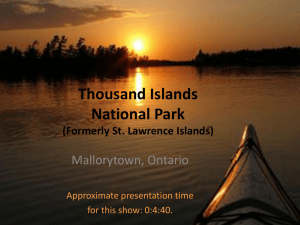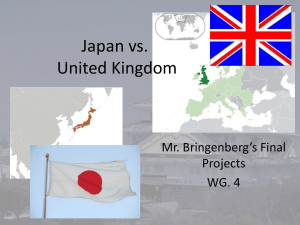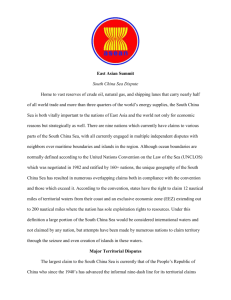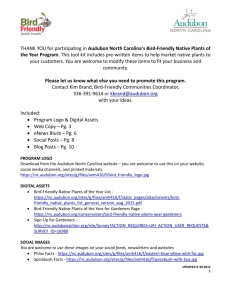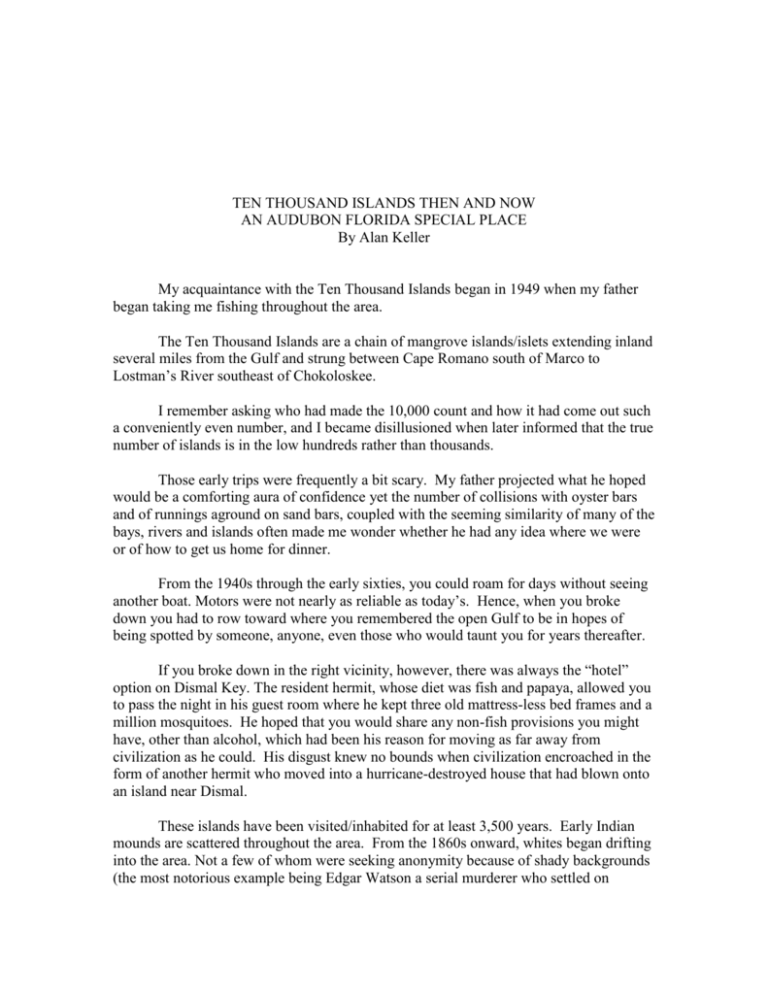
TEN THOUSAND ISLANDS THEN AND NOW
AN AUDUBON FLORIDA SPECIAL PLACE
By Alan Keller
My acquaintance with the Ten Thousand Islands began in 1949 when my father
began taking me fishing throughout the area.
The Ten Thousand Islands are a chain of mangrove islands/islets extending inland
several miles from the Gulf and strung between Cape Romano south of Marco to
Lostman’s River southeast of Chokoloskee.
I remember asking who had made the 10,000 count and how it had come out such
a conveniently even number, and I became disillusioned when later informed that the true
number of islands is in the low hundreds rather than thousands.
Those early trips were frequently a bit scary. My father projected what he hoped
would be a comforting aura of confidence yet the number of collisions with oyster bars
and of runnings aground on sand bars, coupled with the seeming similarity of many of the
bays, rivers and islands often made me wonder whether he had any idea where we were
or of how to get us home for dinner.
From the 1940s through the early sixties, you could roam for days without seeing
another boat. Motors were not nearly as reliable as today’s. Hence, when you broke
down you had to row toward where you remembered the open Gulf to be in hopes of
being spotted by someone, anyone, even those who would taunt you for years thereafter.
If you broke down in the right vicinity, however, there was always the “hotel”
option on Dismal Key. The resident hermit, whose diet was fish and papaya, allowed you
to pass the night in his guest room where he kept three old mattress-less bed frames and a
million mosquitoes. He hoped that you would share any non-fish provisions you might
have, other than alcohol, which had been his reason for moving as far away from
civilization as he could. His disgust knew no bounds when civilization encroached in the
form of another hermit who moved into a hurricane-destroyed house that had blown onto
an island near Dismal.
These islands have been visited/inhabited for at least 3,500 years. Early Indian
mounds are scattered throughout the area. From the 1860s onward, whites began drifting
into the area. Not a few of whom were seeking anonymity because of shady backgrounds
(the most notorious example being Edgar Watson a serial murderer who settled on
Lostman’s River and is the subject of Peter Matthiessen’s masterful novel Killing Mr.
Watson). Also drifting into the area were blacks fleeing slavery, and Civil War deserters.
The principal settlements became Chokoloskee and Everglades City.
In the mid 20th century the area hosted professional fishermen, some of whom
supplemented their incomes by harvesting “square groupers” (marijuana bales dropped at
sea), and dedicated sport fishermen.
Fishing was excellent through the 1960s when less than 60 fish, typically
including sea trout, snook, redfish, grouper, snappers, and occasionally tarpon, seemed a
poor daily haul indeed. Today, however, few would argue that fishing is nearly as
productive as in the “good old days.”
So why visit the Ten Thousand Islands if the fishing is not what it was? With
fewer fish on the other end of the fishing line one can now better appreciate how varied
the land and seascapes really are. Outer islands, slowly sinking into a rising sea, still
offer relatively deserted beaches. The mangrove islands, which serve as nurseries for
many species of fish and havens for a variety of bird life, have a great and peaceful
beauty, as do the numerous rivers and creeks dividing them. Indian shell mounds in
places like Dismal Key, Lostman’s River, and Chokoloskee (Old Home) provoke a sense
of wonder at human survival in such a place. And the presence of other boats makes
rowing a less common necessity.
It is advisable to see the area sooner rather than later since polluted water runoff
and sea level rise, barring considerable efforts to stop them, will continue to negatively
impact the landscape and wildlife populations of the area.
To access the Ten Thousand Islands, boat tours from the Everglades National
Park are available as well as private operators and boat rentals in Goodland, Everglades
City, Chokoloskee, and Port of the Islands.
This column is one of a series from AUDUBON FLORIDA. Alan Keller, PhD, is
a member of the AUDUBON FLORIDA BOARD and a former advisor to developing
counties through the World Health Organization. For more about the Ten Thousand
Islands visit www.nps.gov/ever/planyourvisit/tenthousandislands. For more about
AUDUBON FLORIDA and its “Special Places” program visit
www.FloridaSpecialPlaces.org. All rights reserved for Florida Audubon Society, Inc.
Ted Below photo, Collier Audubon Society
Ted Below photo, Collier Audubon Society
Ted Below photo, Collier Audubon Society



